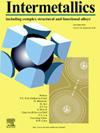Machine learning-accelerated prediction of mechanical and microstructural properties of BCC Fe–Cr–Ni–Al high-entropy alloys across the full compositional space
IF 4.3
2区 材料科学
Q2 CHEMISTRY, PHYSICAL
引用次数: 0
Abstract
This study employs machine learning to accelerate the computation of mechanical properties and microstructural characteristics of BCC FeCrNiAl high-entropy alloys across the entire compositional range. Initially, 49 representative compositional points were selected within the compositional space, encompassing unary to quaternary alloys. Based on ab initio calculations using density functional theory, theoretical Young's modulus, bulk modulus, brittleness-toughness indicators, deviation of atomic positions, shape deformation ratio, and density were obtained. The Categorical Boosting algorithm was then used to develop a composition-property model, predicting properties across the full compositional space. Alloy properties were mapped onto a 2-D plane for systematic analysis, and the SHAP method was used to quantify the influence of individual elements. It was found that fine-tuning the composition can achieve simultaneous optimization of strength and toughness. Specifically, adjusting the Cr content at high FeNi levels effectively enhances ductility, while keeping Al content within the maximum permissible range is crucial for engineering applications that require a balance between strength and density. Further exploration was conducted on the characteristics of the FeAl(CrNi)x series alloys. This study highlights the potential of machine learning to accelerate ab initio calculations methods for complex alloys, improving efficiency and providing a basis for designing and optimizing FeCrNiAl HEAs.

BCC Fe-Cr-Ni-Al高熵合金全成分空间力学和显微组织性能的机器学习加速预测
本研究采用机器学习加速计算BCC FeCrNiAl高熵合金在整个成分范围内的力学性能和显微组织特征。最初,在成分空间中选择了49个具有代表性的成分点,包括一元到四元合金。基于密度泛函理论从头计算,得到了理论杨氏模量、体积模量、脆韧性指标、原子位置偏差、形状变形比和密度。然后使用分类增强算法开发一个组合属性模型,预测整个组合空间的属性。将合金性能映射到二维平面上进行系统分析,并使用SHAP方法量化各个元素的影响。研究发现,通过对成分进行微调,可以实现强度和韧性的同时优化。具体来说,在高FeNi水平下调整Cr含量可以有效地提高塑性,而将Al含量保持在最大允许范围内对于需要在强度和密度之间取得平衡的工程应用至关重要。对FeAl(CrNi)x系列合金的性能进行了进一步的研究。该研究强调了机器学习在加速复杂合金从头计算方法、提高效率以及为设计和优化FeCrNiAl HEAs提供基础方面的潜力。
本文章由计算机程序翻译,如有差异,请以英文原文为准。
求助全文
约1分钟内获得全文
求助全文
来源期刊

Intermetallics
工程技术-材料科学:综合
CiteScore
7.80
自引率
9.10%
发文量
291
审稿时长
37 days
期刊介绍:
This journal is a platform for publishing innovative research and overviews for advancing our understanding of the structure, property, and functionality of complex metallic alloys, including intermetallics, metallic glasses, and high entropy alloys.
The journal reports the science and engineering of metallic materials in the following aspects:
Theories and experiments which address the relationship between property and structure in all length scales.
Physical modeling and numerical simulations which provide a comprehensive understanding of experimental observations.
Stimulated methodologies to characterize the structure and chemistry of materials that correlate the properties.
Technological applications resulting from the understanding of property-structure relationship in materials.
Novel and cutting-edge results warranting rapid communication.
The journal also publishes special issues on selected topics and overviews by invitation only.
 求助内容:
求助内容: 应助结果提醒方式:
应助结果提醒方式:


